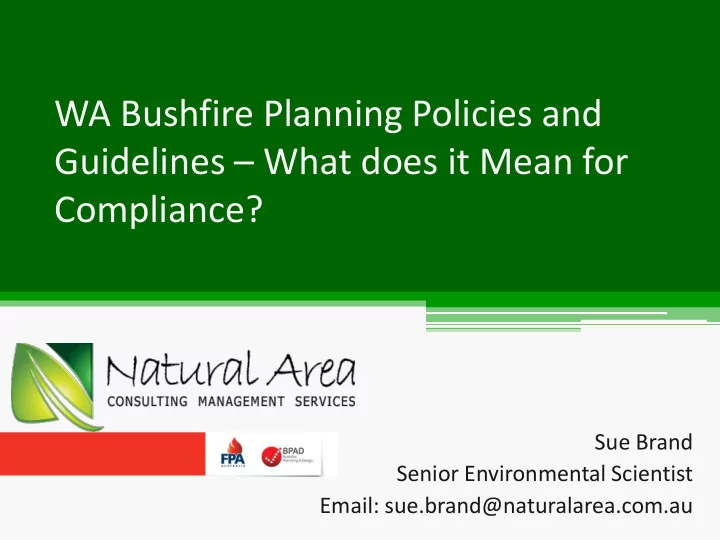

WA Bushfire Planning Policies and Guidelines – What does it Mean for Compliance? Sue Brand Senior Environmental Scientist Email: sue.brand@naturalarea.com.au
Introduction Background and introduction Legislative Requirements ▫ SPP 3.7 ▫ Bushfire prone mapping ▫ Planning for Bushfire Protection Guidelines ▫ AS 3959 – 2009 Bushfire practitioners and accreditation Relevance to revegetation/restoration Acknowledgements Questions
Background Environmental scientist Worked in TAFE and consulting sectors Bushfire planning practitioner 5+ years Accredited Level 2 bushfire planning and design(BPAD) accreditation through Fire Protection Association of Australia
Legislation and Policies State Planning Policy 3.7 Planning in Bushfire Prone Areas (WA) Guidelines for Planning in Bushfire Prone Areas (WA) Planning and Development Act 2005 (WA) Planning and Development Regulations 2009 (WA) Planning and Development (Local Planning Scheme) Regulations 2015 (WA) Fire and Emergency Services Act 1998 (WA) Building Act 2011 (WA) Building Regulations 2012 (WA) Building Code of Australia (National Construction Code)
Bushfire Prone Mapping Bushfire prone area means land designated by an order made under Section 18P of the Fire and Emergency Services Act 1998 Designation undertake by Office of Bushfire Risk Management (OBRM) Online December 2015, updated May 2016
SPP 3.7 Councils must have due regard to the policy, or they must give respect and consideration to it Requires consideration of bushfire hazard at various stages of the planning process Common outputs of the process: ▫ Bushfire Hazard Assessment ▫ BAL-contour map and BAL-assessment ▫ Bushfire Management Plan
SPP 3.7
Bushfire Hazard Assessment Example pre-development bushfire hazard
BAL-Contour, BAL-assessment BAL = bushfire attack level Considers the presence of bushland areas (classified vegetation) and its proximity to urban development, along with vegetation type and slope Majority of house fires in proximity to bushland are within 100 m of the vegetated areas Bushfire hazard considers the separation distance to building walls and associated risks of smoke, ember attack and flames Scale map of a development site including proposed lot layout and indicative BAL-ratings; indicates potential bushfire attack levels and radiant heat impacts, thus identifies land suitable and unsuitable for development
BAL Construction Levels
Bushfire Protection Criteria Performance-based system of assessing bushfire risk management measures Consists of four elements 1 – Location - 2 – Siting and design of development - 3 – Vehicular access - 4 – Water - Each has an intent that outlines the desired outcomes for the element (performance principle and acceptable solutions) Assessment typically documented in a Bushfire Management Plan
Bushfire Protection Criteria Element 3 – Vehicular Access Element 1 – Location • Two access routes Development is located in an area that is • Technical requirements for: • or will, on completion, be subject to Public road • either a moderate or low bushfire hazard Cul-de-sac • Battle Axe level, or BAL-29 or below. • Private driveway >50 m • Emergency access way Element 2 – Siting And Design • Fire service access routes. • Asset Protection Zone – minimum 20 m. Where 20 m not possible, APZ sufficient Element 4 – Water enough to ensure potential radiant heat • Reticulated water supply, or impact of a fire does not exceed 29 kW/m 2 . • Provision of water tanks for fire fighting purposes.
Implications for Revegetation Development will result in clearing of vegetation and also the landscaping and/or revegetation Revegetation can create areas of classified vegetation that can impact on the various bushfire assessments and the need for a building to have a BAL-rating Important to consider revegetation in early stages of the planning process
Implications for Revegetation Revegetation considerations could include: Species selection Planting density and locations Weed control Spatial area to be planted Proximity to other classified vegetation Future maintenance requirements (e.g.: fire fuel loads)
Revegetated POS
Key Messages Bushfire implications need to be considered early in the planning process Landscaping and revegetation activities also need to be considered early due to their potential impacts on BAL-ratings within a subdivision
Acknowledgements Chris Wyborn, Engagement and Education Manager, Fire Protection Association of Australia
Questions? Presenter: Natural Area: Sue Brand Head Office Senior Environmental Scientist 99c Lord Street, Whiteman Natural Area Perth WA, 6068 sue.brand@naturalrea.com.au P 08 9209 2767 E info@naturalarea.com.au www.naturalarea.com.au
Recommend
More recommend